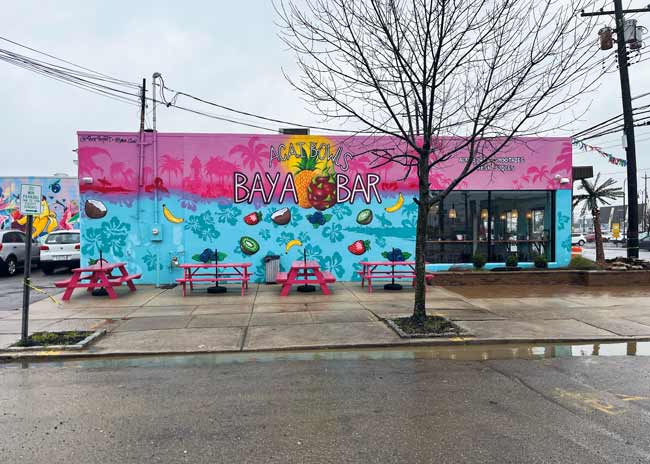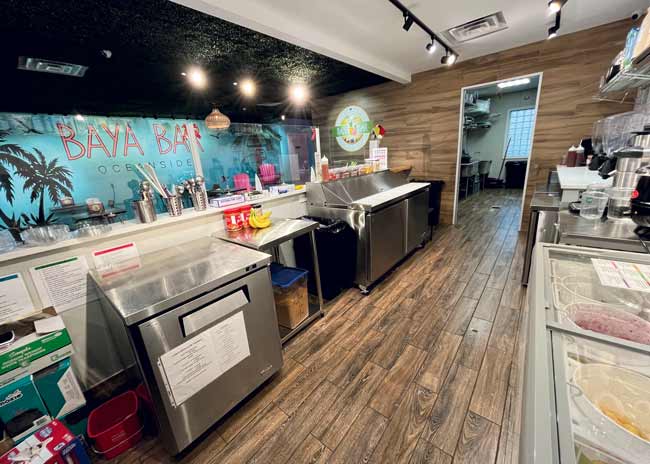Focused on smart real estate choices and a compact footprint, this chain could soon reach 50-plus locations in the Big Apple.
Acai bowls may be characterized as a West Coast food, but acai concept Baya Bar has a New York origin story. Bill Loesch, a former stockbroker who wanted out of Wall Street, founded the chain in 2016 after he left the financial sector to build his own business. After some research, he found an opening in acai bowls. These offerings had a foothold in California and were moving east but hadn’t taken hold in New York City yet. While smoothie and juice places offered acai, he wasn’t aware of any dedicated bowl chains in the city.
Loesch saw not only an opportunity but also one he could seize. “Before this, I was not a food and beverage guy from a trade standpoint. I have no experience cooking or setting up kitchens or anything of that magnitude,” he says. “What I loved about this concept is that it was so simple. You had frozen fruits, fresh fruits and shelf-stable items. Anybody can learn this.”

Enthusiastic about this prospect, Loesch then set about learning. He visited acai concepts in California and up and down the East Coast, researching menus, ingredient costs, real estate and everything else that goes into opening a restaurant.
Through this work, Loesch developed the menu and overall concept for Baya Bar. On Dec. 28, 2016, he opened the first location. Within a year, he started three corporate restaurants. The first franchise locations opened just a few months after that. Now, more than six years later, Baya Bar has 25 locations — almost all in New York City.
One of the keys to Baya Bar’s successes, says Loesch, is its approach to quality versus quantity. Baya Bar, he says, offers better food in larger portions compared with competitors, sacrificing margins in exchange for market share. “I knew that over time, as we continue to grow, with size and scale we would get our costs down, but we would also dominate the markets we were in. If we were first to market, it would be very tough for someone to come in and dethrone us. If we were competing with other brands, I feel consumers at some point would have logic kick in. They’d see the same size or bigger, and higher quality for the same price,” he explains.
In addition to developing the menu and strategy, Loesch worked on Baya Bar’s actual brand. The chain, he says, has a laid-back, tropical vibe. Key interior features include artificial grass on the ceiling and fake palm trees when they can fit in the space. The tropical color scheme includes aquas, pinks and greens, which play an important part in the design.
As part of this laid-back vibe, Baya Bar steers clear of elements that make it feel too corporate or chain-like. Instead of electronic menu boards, the company uses hand-painted chalkboards, for instance.
It also designs its stores with the specific location in mind. “We’re looking at the other stores in the neighborhood. If stores don’t have illuminated signs, we might go with a non-illuminated sign and have gooseneck lighting to vibe with the rest of the neighborhood,” Loesch explains. “We want to look unique compared to the other stores, and we want to follow our brand guidelines, but we also want to have a level of blending in to complement the neighborhood.”
 The interior has a relaxed, tropical feel. Key design elements include the grass ceiling and wood-style tile.
The interior has a relaxed, tropical feel. Key design elements include the grass ceiling and wood-style tile.
New York Small
On top of this general appearance and atmosphere, one aspect of Baya Bar that stands out is its store size.
Baya Bar locations are small, even by New York City standards. The tiniest restaurant in the system squeezes into just 250 square feet, though “that is really tight,” admits Loesch. Much more reasonable is 500 to 750 square feet, he says — adding that the top-selling store in the system grosses more than $1 million a year in just 450 square feet.
Such small footprints obviously help limit the overhead of a typical Baya Bar location. However, Loesch thinks of these small spaces as doing more than just limiting rent. “[It’s] more about smaller footprints so you can fit in higher rent areas and not take a ton of square footage,” he says, adding that they also don’t shy away from extremely high rent locations in certain areas of Manhattan.
Being so small and flexible in terms of square footage means that Baya Bar must be flexible with its store design. The smallest restaurants, for instance, do not have a prep area in the back of the house, so all prep must occur up front. The lack of space also means more prep work has to take place throughout the day. To help with this, says Loesch, at smaller stores, a team member comes in about half an hour earlier than at standard-sized restaurants to cut fresh produce and proportion acai.
There’s a balancing act, then, between store size and labor costs. Baya Bar, Loesch notes, puts its thumb on the scales with some creative scheduling. For instance, it often cuts 15 minutes off the beginning and end of employee shifts. That leaves the restaurant on a skeleton crew for just a few minutes at a time, but, he says, “15 minutes in the morning, 15 minutes at night. That’s three-and-a-half hours a week, every week. That adds up.”
The concept’s flexibility also applies to its equipment layout and size. Loesch notes the company shifts pieces around based on the footprint and will often shrink pieces down to fit the space.
The typical Baya Bar has about five core pieces of equipment. One of these is the dipping cabinet, which holds acai, pitaya (dragon fruit) sorbet and frozen fruits. This piece, says Loesch, must be 5 feet in length, no matter the size of the restaurant. There just isn’t enough room in smaller cabinets to hold all of Baya Bar’s ingredients, he explains.
Baya Bar often uses the dipping cabinet in conjunction with a low-boy freezer, often a 180-degree turn away from the dipping cabinet. The freezer holds around 15 bowls that staff preportion with acai. Notably, the temperature of this unit is set to about 15 degrees F, making acai soft enough to eat with a spoon.
When a customer orders an acai bowl, the staff member retrieves one of these preportioned containers and moves to a nearby cold table. On top, the chain has fresh fruit stored in wells, including sliced strawberries, kiwi and pineapple, along with whole blueberries. Backup ingredients are stored below, while fresh bananas are stored on a shelf overhead, ready to be peeled, sliced and added to a bowl. This cold table is one where there’s some flexibility in size. Ideally it is a 5-foot unit, but it can be 4 or even
3 feet if necessary, Loesch says.
After adding fresh fruit to a bowl, the team member adds toppings like coconut flakes and granola, applies a drizzle of Nutella or peanut butter, puts on the bowl’s lid, and hands it to the customer.
If customers order a smoothie, the process starts at a separate undercounter refrigerator. This unit holds fresh produce for juices, with the juicer on top. It’s also home to smoothie bases like coconut milk and apple juice. From there, the staffer moves to the dipping cabinet for frozen ingredients like acai and frozen fruit, then to the small front-of-the-house ice machine before blending.
The typical Baya Bar has two to three blenders, with a spare in the back of the house, Loesch adds. This spare is often plugged in and on-call if needed during peak hours.
If the restaurant does have a back-of-the-house prep area, it includes a three-bay sink and a produce sink. No matter what, the back also has an upright refrigerator and upright freezer for storage. The company uses its cold units in the front as storage spaces as well.
 Baya Bar has only a few pieces of cold equipment that can be shifted, and in some cases resized, depending on the store’s footprint. These include a cold table, undercounter refrigeration and a dipping cabinet.
Baya Bar has only a few pieces of cold equipment that can be shifted, and in some cases resized, depending on the store’s footprint. These include a cold table, undercounter refrigeration and a dipping cabinet.
Filling in the City
With an impressively compact footprint and disciplined management, Baya Bar has been able to grow to 25 units. By the end of 2023, the chain expects to have 50 locations either open or under contract, Loesch says.
Most of this growth will come through new franchised locations. According to Loesch, Baya Bar locations do best when there is an owner-operator that oversees the business rather than an investor who hires a manager and then steps away. The owner-operator doesn’t need to be on-site daily but does need to keep a close eye on inventory and labor costs in order to maximize their investment.
While the chain is open to partnering with non-owner-operators, Loesch says, it is a great fit for “blue-collar style people who want to be their own boss.” The operation’s simplicity aligns well with this type of franchisee too. Running a Baya Bar doesn’t require significant foodservice experience, just a willingness to learn and work hard.
As Baya Bar grows, the company will initially keep its focus on New York City. Loesch says the chain could double in size in the five boroughs before expanding in the tri-state area and eventually up and down the East Coast.
Obviously, Baya Bar does well in dense urban areas. As it expands, it will continue to seek those spaces. It does especially well with 15- to 25-year-old customers, so stores near universities or large high schools represent opportunities for growth.
As it grows, the company will staff up as necessary. Loesch expects that the chain won’t need to add much manpower for franchise support, however. The simplicity of the operation means franchisees don’t lean on corporate too often.
“We were so on top of [our franchisees] that they were basically telling us to leave them alone,” Loesch says. As long as corporate provides high-level support when franchisees do reach out, he says franchisees told them they prefer not to receive texts multiple times a week or even weekly phone calls.
Instead of franchise support staffers, Loesch notes he plans to add expertise in key areas like scaling, operating and negotiating distribution deals. Those are the people, he says, that will take Baya Bar to the next level.
Though it’s hardly inevitable, Loesch believes that several levels up, the concept could reach a value of $1 billion. It’s a target he’s had from the beginning — one that he applies to any venture he enters.
Though Loesch has left the financial sector, he clearly hasn’t left the Wall Street mindset or his Wall Street skills behind entirely. Only time will tell if Baya Bar will hit the $1 billion mark; but if it does, his acai bowl concept will owe a lot to the lessons of the Big Apple.



